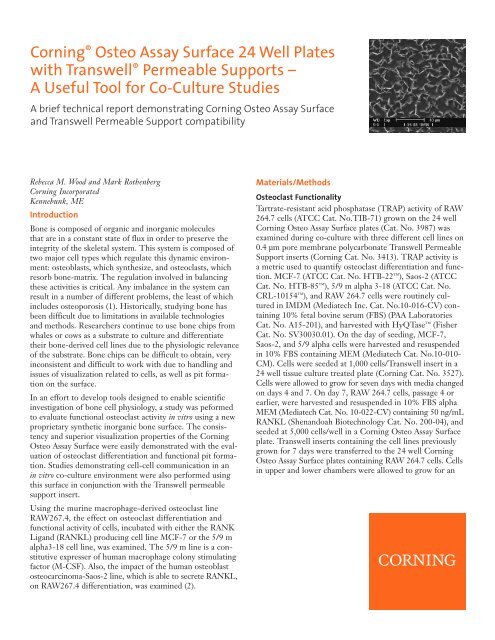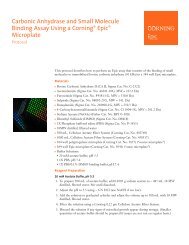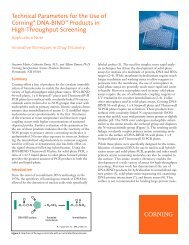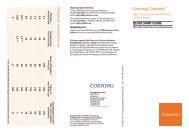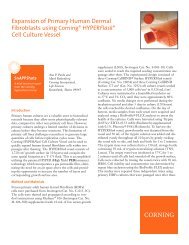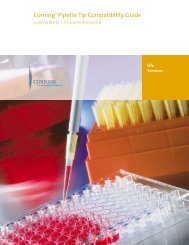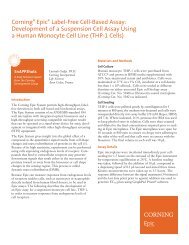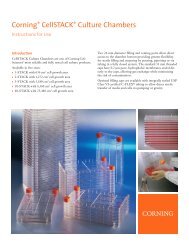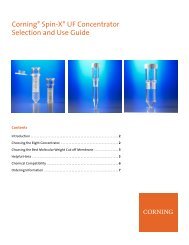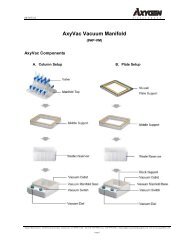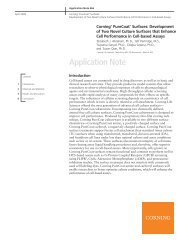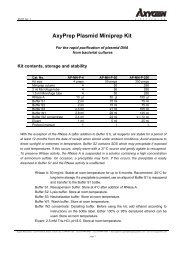Corning® Osteo Assay Surface 24 Well Plates with Transwell ...
Corning® Osteo Assay Surface 24 Well Plates with Transwell ...
Corning® Osteo Assay Surface 24 Well Plates with Transwell ...
You also want an ePaper? Increase the reach of your titles
YUMPU automatically turns print PDFs into web optimized ePapers that Google loves.
Corning ® <strong>Osteo</strong> <strong>Assay</strong> <strong>Surface</strong> <strong>24</strong> <strong>Well</strong> <strong>Plates</strong><br />
<strong>with</strong> <strong>Transwell</strong> ® Permeable Supports –<br />
A Useful Tool for Co-Culture Studies<br />
A brief technical report demonstrating Corning <strong>Osteo</strong> <strong>Assay</strong> <strong>Surface</strong><br />
and <strong>Transwell</strong> Permeable Support compatibility<br />
Rebecca M. Wood and Mark Rothenberg<br />
Corning Incorporated<br />
Kennebunk, ME<br />
Introduction<br />
Bone is composed of organic and inorganic molecules<br />
that are in a constant state of flux in order to preserve the<br />
integrity of the skeletal system. This system is composed of<br />
two major cell types which regulate this dynamic environment:<br />
osteoblasts, which synthesize, and osteoclasts, which<br />
resorb bone-matrix. The regulation involved in balancing<br />
these activities is critical. Any imbalance in the system can<br />
result in a number of different problems, the least of which<br />
includes osteoporosis (1). Historically, studying bone has<br />
been difficult due to limitations in available technologies<br />
and methods. Researchers continue to use bone chips from<br />
whales or cows as a substrate to culture and differentiate<br />
their bone-derived cell lines due to the physiologic relevance<br />
of the substrate. Bone chips can be difficult to obtain, very<br />
inconsistent and difficult to work <strong>with</strong> due to handling and<br />
issues of visualization related to cells, as well as pit formation<br />
on the surface.<br />
In an effort to develop tools designed to enable scientific<br />
investigation of bone cell physiology, a study was peformed<br />
to evaluate functional osteoclast activity in vitro using a new<br />
proprietary synthetic inorganic bone surface. The consistency<br />
and superior visualization properties of the Corning<br />
<strong>Osteo</strong> <strong>Assay</strong> <strong>Surface</strong> were easily demonstrated <strong>with</strong> the evaluation<br />
of osteoclast differentiation and functional pit formation.<br />
Studies demonstrating cell-cell communication in an<br />
in vitro co-culture environment were also performed using<br />
this surface in conjunction <strong>with</strong> the <strong>Transwell</strong> permeable<br />
support insert.<br />
Using the murine macrophage-derived osteoclast line<br />
RAW267.4, the effect on osteoclast differentiation and<br />
functional activity of cells, incubated <strong>with</strong> either the RANK<br />
Ligand (RANKL) producing cell line MCF-7 or the 5/9 m<br />
alpha3-18 cell line, was examined. The 5/9 m line is a constitutive<br />
expresser of human macrophage colony stimulating<br />
factor (M-CSF). Also, the impact of the human osteoblast<br />
osteocarcinoma-Saos-2 line, which is able to secrete RANKL,<br />
on RAW267.4 differentiation, was examined (2).<br />
Materials/Methods<br />
<strong>Osteo</strong>clast Functionality<br />
Tartrate-resistant acid phosphatase (TRAP) activity of RAW<br />
264.7 cells (ATCC Cat. No.TIB-71) grown on the <strong>24</strong> well<br />
Corning <strong>Osteo</strong> <strong>Assay</strong> <strong>Surface</strong> plates (Cat. No. 3987) was<br />
examined during co-culture <strong>with</strong> three different cell lines on<br />
0.4 µm pore membrane polycarbonate <strong>Transwell</strong> Permeable<br />
Support inserts (Corning Cat. No. 3413). TRAP activity is<br />
a metric used to quantify osteoclast differentiation and function.<br />
MCF-7 (ATCC Cat. No. HTB-22 ), Saos-2 (ATCC<br />
Cat. No. HTB-85 ), 5/9 m alpha 3-18 (ATCC Cat. No.<br />
CRL-10154 ), and RAW 264.7 cells were routinely cultured<br />
in IMDM (Mediatech Inc. Cat. No.10-016-CV) containing<br />
10% fetal bovine serum (FBS) (PAA Laboratories<br />
Cat. No. A15-201), and harvested <strong>with</strong> HyQTase (Fisher<br />
Cat. No. SV30030.01). On the day of seeding, MCF-7,<br />
Saos-2, and 5/9 alpha cells were harvested and resuspended<br />
in 10% FBS containing MEM (Mediatech Cat. No.10-010-<br />
CM). Cells were seeded at 1,000 cells/<strong>Transwell</strong> insert in a<br />
<strong>24</strong> well tissue culture treated plate (Corning Cat. No. 3527).<br />
Cells were allowed to grow for seven days <strong>with</strong> media changed<br />
on days 4 and 7. On day 7, RAW 264.7 cells, passage 4 or<br />
earlier, were harvested and resuspended in 10% FBS alpha<br />
MEM (Mediatech Cat. No. 10-022-CV) containing 50 ng/mL<br />
RANKL (Shenandoah Biotechnology Cat. No. 200-04), and<br />
seeded at 5,000 cells/well in a Corning <strong>Osteo</strong> <strong>Assay</strong> <strong>Surface</strong><br />
plate. <strong>Transwell</strong> inserts containing the cell lines previously<br />
grown for 7 days were transferred to the <strong>24</strong> well Corning<br />
<strong>Osteo</strong> <strong>Assay</strong> <strong>Surface</strong> plates containing RAW 264.7 cells. Cells<br />
in upper and lower chambers were allowed to grow for an
additional 7 days <strong>with</strong> a media change on day 4 (10% alpha<br />
MEM containing 50 ng/mL RANKL). The culture period<br />
chosen was based on previously published research in order<br />
to achieve optimal cytokine production (3). On day 7, inserts<br />
were removed and discarded, and medium from the Corning ®<br />
<strong>Osteo</strong> <strong>Assay</strong> <strong>Surface</strong> plate was sampled for TRAP activity<br />
following the manufacturers protocol (B-Bridge Cat. No.<br />
AK04). As an internal control, RAW267.4 cells were also differentiated<br />
<strong>with</strong>out additional cell lines but in the presence<br />
of RANKL. Differentiated osteoclasts were stained using<br />
the Millipore ® Actin Cytoskeleton and Focal Adhesion<br />
Staining Kit (Millipore Cat. No. FAK100) for both actin<br />
and nuclear localization. Cells were visualized using the<br />
EVOS ® fl microscope (AMG Advanced Microscopy<br />
Group).<br />
Results and Discussion<br />
To establish the feasibility of using a co-culturing technique<br />
to study bone cell physiology, two unique platforms from<br />
Corning Life Sciences were utilized. The study used the<br />
Corning <strong>Osteo</strong> <strong>Assay</strong> <strong>Surface</strong> in conjunction <strong>with</strong> <strong>Transwell</strong> ®<br />
permeable supports. The impact of three cell lines (MCF-7,<br />
5/9 m alpha 3-18 and the Saos-1) on osteoclast differentiation<br />
was examined. The three lines are known to express<br />
important regulators of osteoclast physiology. Figure 1 is a<br />
diagram of how the co-culture system was set up. Figure 2<br />
depicts the result of a 7-day incubation of RAW267.4<br />
cultured on the Corning <strong>Osteo</strong> <strong>Assay</strong> <strong>Surface</strong> <strong>with</strong> MCCF-7,<br />
5/9 m alpha 3-18 and Saos-2 cell lines cultured on the Apical<br />
0.4 µm pore size membrane. At the end of the osteoclast differentiation<br />
period, the inserts containing cells were removed<br />
and TRAP activity of the multiple well plates was analyzed<br />
using the protocol provided by B-bridge. The results (Table<br />
1) show that the 5/9 m alpha 3-18 cell line, a commercially<br />
available CHO line that constitutively expresses M-CSF,<br />
inhibits TRAP activity (Figure 2, 49 ±1%). The data, expressed<br />
as Percent TRAP activity <strong>with</strong> differentiated RAW267.4 as<br />
the control, showed no change in RAW267.4 activity when<br />
co-cultured <strong>with</strong> the MCF-7 cell line (100 ±1%). The human<br />
osteosarcoma line, Saos-2, which under the appropriate conditions<br />
can differentiate into osteoblasts and express RANKL<br />
(2), showed enhanced RAW264.7 differentiation and TRAP<br />
activity (147 ±5%). These data indicate that osteoclast physiology<br />
can be studied and modified using this co-culture<br />
system. Figure 3A and B show differentiated RAW267.4<br />
Table 1. Percent TRAP Activity of Differentiated RAW264.7 Cells<br />
After Co-culture <strong>with</strong> Three Different Cell Lines<br />
Overall (%) Standard Deviation<br />
MCF-7 + RankL 102 0.1<br />
5/9 alpha + RankL 45 0.1<br />
Saos-2 + RankL 141 0.5<br />
200<br />
Percent TRAP Activity of Positive Control<br />
<strong>Transwell</strong> Insert<br />
Cell line of interest<br />
RAW267.4 derived<br />
osteoclasts<br />
Percent TRAP Activity<br />
150<br />
100<br />
50<br />
Synthetic <strong>Osteo</strong><br />
<strong>Assay</strong> <strong>Surface</strong><br />
Pits<br />
0<br />
MCF-7 +<br />
RANKL<br />
5/9 alpha +<br />
RANKL<br />
Saos-2 +<br />
RANKL<br />
Figure 1. Schematic of a <strong>Transwell</strong> Permeable Support – Corning <strong>Osteo</strong><br />
<strong>Assay</strong> <strong>Surface</strong> Co-Culture System<br />
Figure 2. Percent TRAP activity of co-cultures expressed as compared to<br />
control wells containing RAW 264.7 cells in the presence of RANKL. (n=3)
A<br />
F-Actin<br />
B<br />
Viniculin<br />
F-Actin<br />
Nuclei<br />
Nuclei<br />
Viniculin<br />
<strong>Osteo</strong> pits<br />
Figure 3. RAW264.7 cells were grown for 7 days in the presence of RANKL on Corning <strong>Osteo</strong> <strong>Assay</strong> <strong>Surface</strong> <strong>24</strong> well plates. Cells were fixed and stained using<br />
an Actin/Cytoskeleton and Focal Adhesion Staining Kit (Millipore) and visualized using an EVOS® fl microscope. Figures 3A and B are representative<br />
osetoclasts stained using the same protocol.<br />
cells stained <strong>with</strong> Rhodamine-Phalloidin, DAPI, and Vinculin<br />
antibodies to reveal the osteoclast-like structure of the cells<br />
after 7 days of differentiation. The observed staining and<br />
characteristic multinucleated structures present are indicative<br />
of an osteoclast cell. Pit formation can also be observed in<br />
Figure 3B which correlated <strong>with</strong> the TRAP data (data not<br />
shown).<br />
This type of co-culture experimental design can also be used<br />
to examine cellular migration. Figure 4 is an example of how<br />
such an experiment can be set up to examine how osteoclasts<br />
or osteoblasts modulate cancer cell (e.g., breast or prostate)<br />
migration ex vivo.<br />
Conclusions<br />
◗ Utilizing Corning ® 0.4 µm pore size membrane <strong>Transwell</strong> ®<br />
Permeable Supports and the new Corning <strong>Osteo</strong> <strong>Assay</strong><br />
<strong>Surface</strong> technology, co-culture studies can be conducted to<br />
better understand the effects on osteoclast differentiation<br />
and activity.<br />
◗ The Corning <strong>Osteo</strong> <strong>Assay</strong> <strong>Surface</strong> can be used <strong>with</strong><br />
fluorescent techniques to examine cellular markers of<br />
differentiation.<br />
◗ The <strong>Transwell</strong> Permeable Support-Corning <strong>Osteo</strong> <strong>Assay</strong><br />
<strong>Surface</strong> system can be used for examination of a number of<br />
interesting physiologic events, including, but not limited<br />
to, migration of various cell lines where bone or bonerelated<br />
cells may play a role.<br />
<strong>Transwell</strong> Insert<br />
Cell line of interest<br />
RAW267.4 derived<br />
osteoclasts<br />
Synthetic <strong>Osteo</strong><br />
<strong>Assay</strong> <strong>Surface</strong><br />
Pits<br />
Figure 4. Schematic showing the use of the <strong>Transwell</strong> Permeable Support<br />
system <strong>with</strong> the Corning <strong>Osteo</strong> <strong>Assay</strong> <strong>Surface</strong> for migration studies.<br />
References<br />
1. Zhao, W. et al. 2009. The Role of T Cells in <strong>Osteo</strong>porosis, an<br />
Update. Int. J. Clin. Exp. Pathol. 2:544-552.<br />
2. Hofbauer, L.C. et al. 2008. Fatal attraction: why breast cancer<br />
cells home to bone. Breast Cancer Research 10:101.<br />
3. Nicolin, V. et al. 2008. Breast adenocarcinoma MCF-7 cell line<br />
induces spontaneous osteoclastogenesis via a RANK-liganddependent<br />
pathway. Acta Histochemica Vol. 110(5):388-396.
For additional product or technical information, please visit<br />
www.corning.com/lifesciences or call 800.492.1110. Outside<br />
the United States, please call +1.978.442.2200.<br />
Corning Incorporated<br />
Life Sciences<br />
Tower 2, 4th Floor<br />
900 Chelmsford St.<br />
Lowell, MA 01851<br />
t 800.492.1110<br />
t 978.442.2200<br />
f 978.442.<strong>24</strong>76<br />
www.corning.com/lifesciences<br />
Worldwide<br />
Support Offices<br />
A S I A / P A C I F I C<br />
Australia/New Zealand<br />
t 0402-794-347<br />
China<br />
t 86 21 2215 2888<br />
f 86 21 6215 2988<br />
India<br />
t 91 1<strong>24</strong> 4604000<br />
f 91 1<strong>24</strong> 4604099<br />
Japan<br />
t 81 3-3586 1996<br />
f 81 3-3586 1291<br />
Korea<br />
t 82 2-796-9500<br />
f 82 2-796-9300<br />
Singapore<br />
t 65 6733-6511<br />
f 65 6861-2913<br />
Taiwan<br />
t 886 2-2716-0338<br />
f 886 2-2516-7500<br />
Corning and <strong>Transwell</strong> are registered trademarks of Corning Incorporated, Corning, NY.<br />
All other trademarks in this document are the property of their respective owners.<br />
Corning Incorporated, One Riverfront Plaza, Corning, NY 14831-0001<br />
E U R O P E<br />
France<br />
t 0800 916 882<br />
f 0800 918 636<br />
Germany<br />
t 0800 101 1153<br />
f 0800 101 <strong>24</strong>27<br />
The Netherlands<br />
t 31 20 655 79 28<br />
f 31 20 659 76 73<br />
United Kingdom<br />
t 0800 376 8660<br />
f 0800 279 1117<br />
All Other European<br />
Countries<br />
t 31 (0) 20 659 60 51<br />
f 31 (0) 20 659 76 73<br />
L AT I N A M E R I C A<br />
Brasil<br />
t (55-11) 3089-7419<br />
f (55-11) 3167-0700<br />
Mexico<br />
t (52-81) 8158-8400<br />
f (52-81) 8313-8589<br />
© 2011 Corning Incorporated Printed in U.S.A. 5/11 POD CLS-AN-173


